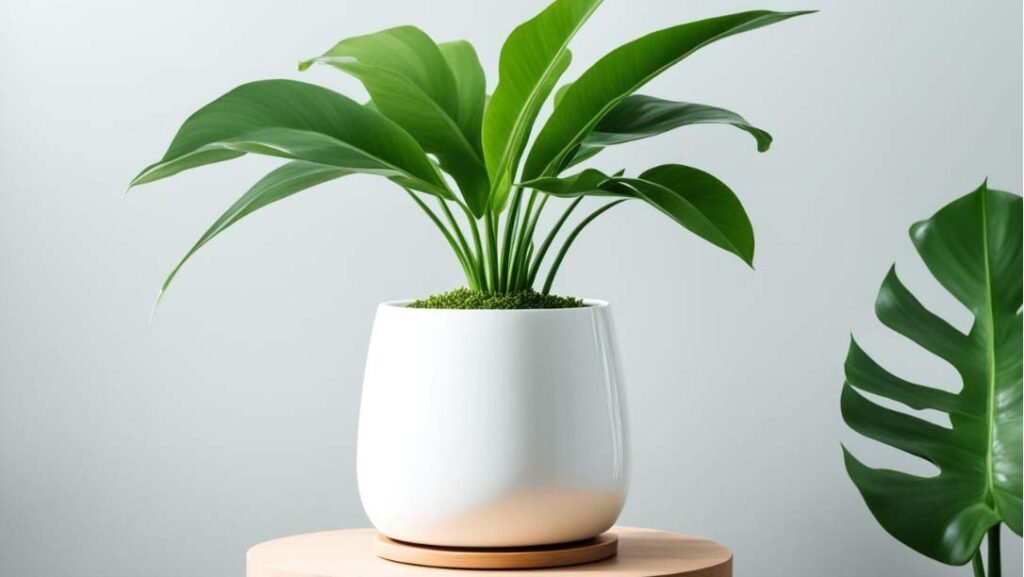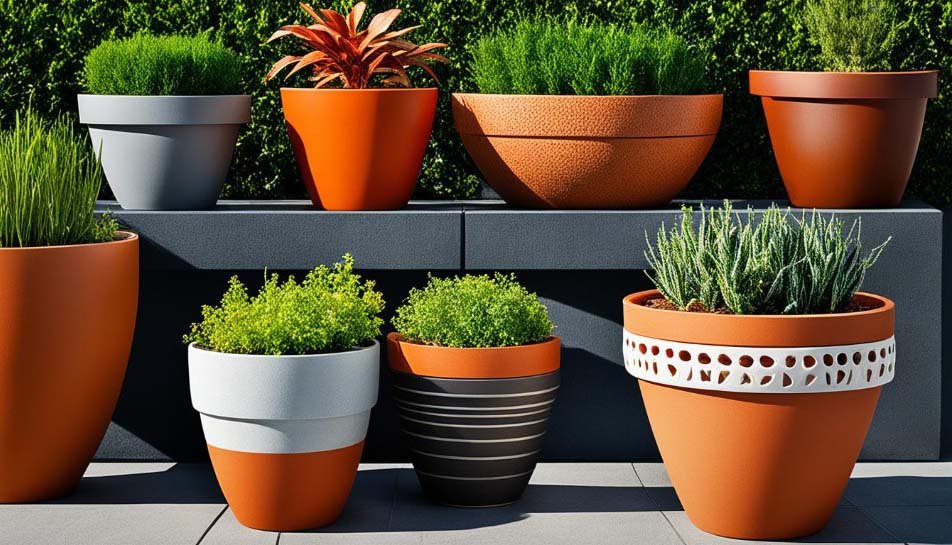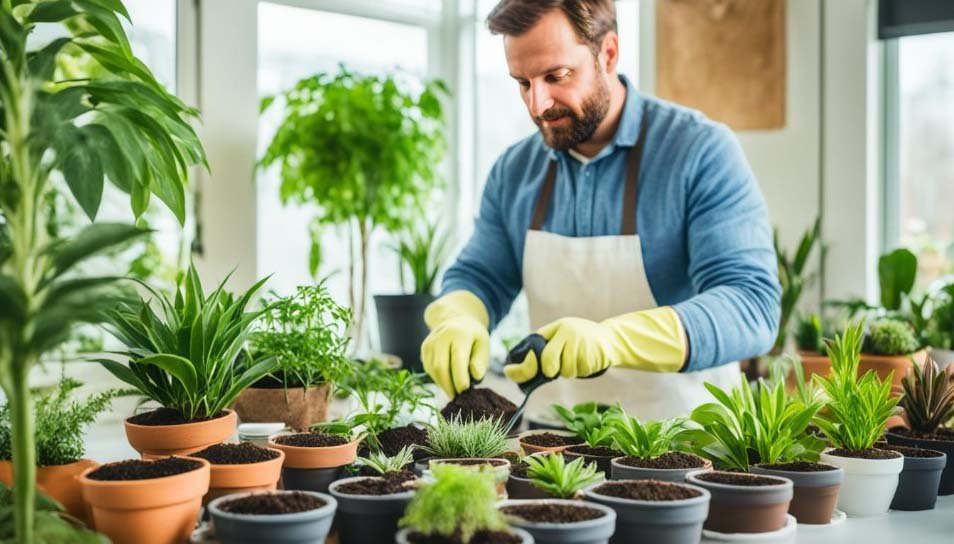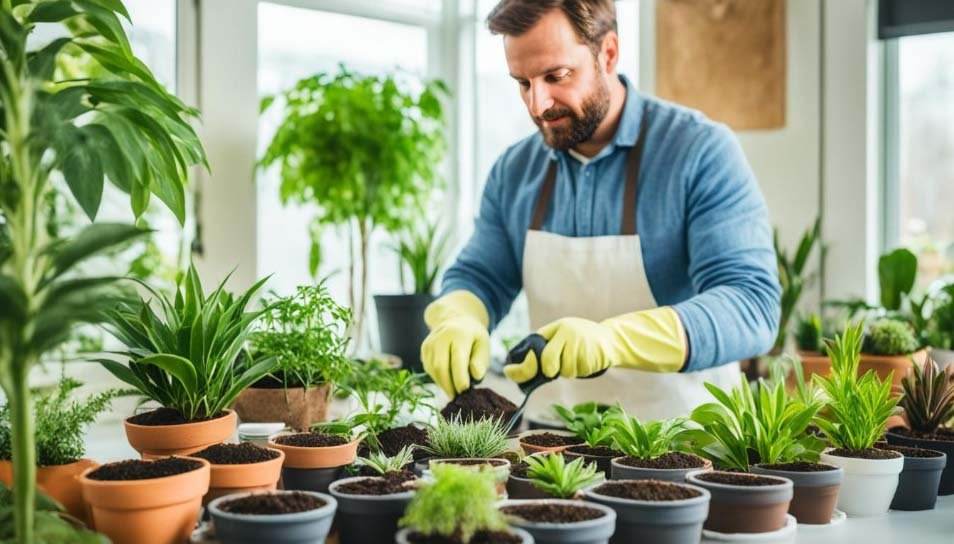Hey, congrats on your new plant! The first step in caring for it is finding the right pot. A pot is smaller and holds one plant, while a planter is bigger and can have several. It’s key to repot your plant. This move boosts its health by giving it fresh soil to grow in. Also, picking the right pot size helps your plant stay healthy and maybe even get bigger.

Key Takeaways
- Choosing the right pot is crucial for the health and growth of your indoor plant.
- Pots and planters have different purposes, with pots being smaller and designed for single plants.
- Repotting your plant regularly provides fresh potting mix and allows for growth over time.
- The size of the pot impacts the air-to-water ratio and affects how much your plant can grow.
- Understanding the specific needs of your indoor plant will help you select the perfect pot for its care.
Why Repotting is Essential
Repotting your indoor plants is key for their growth and health. As plants grow, they need more space for their roots. This can make them root-bound and limit their access to water and nutrients.
Plant Growth and Health
Plants become root-bound when their roots can’t grow out. This leads to a weaker plant that might not look its best. By repotting into a bigger pot, the roots can spread out. This helps the plant get all the nutrients it needs for healthy, beautiful growth.
Fresh Potting Mix
Repotting also gives you a chance to change the potting mix. Over time, the old mix loses nutrients and can get packed. It might also pick up salts and impurities. By adding fresh, nutrient-rich soil, you help the plant get the food it craves.
Repotting can also stop problems like root rot. A good, draining pot and the right potting mix keeps water from sitting around the roots.
This keeps the roots healthy and well-aerated, reducing the risk of diseases like root rot.
“Repotting is crucial for the long-term health and growth of indoor plants.. It provides them with the space and nutrients they need to thrive.”
Therefore, repotting is crucial for maintaining your indoor plants’ happiness and health. It allows them room to grow and access to fresh soil for nutrients, helping your plants remain strong and vibrant.
Understanding Pot Sizes
Choosing the right pot size for your indoor plants is key. It’s not about how big the plants are. It’s about how big the pots are, measured by their diameter. This choice influences your plant’s growth and health.
For plants in pots 10 inches or smaller, pick a pot 1-2 inches bigger. This gives them space to grow. For bigger plants in pots over 10 inches, a pot that is 2-3 inches larger is better.
Indoor plant pot sizes range from two to seven inches for smaller plants. Larger plants need pots ten to thirty inches wide, which are usually for outdoor use. Remember, when you’re repotting, increase the diameter by at least 1-2 inches for smaller pots and 2-3 inches for bigger ones.
A study by the Society for Experimental Biology found that potted plants grow their roots towards the edges as they get bigger. So, choosing the right container is vital for the plant to keep growing and stay healthy.
Danger awaits if your pots are the wrong size. Small pots starve plants. Big pots drown them, causing root rot and inviting pests.
A good rule is to have a pot about two inches larger than the plant itself. Go bigger gradually to avoid issues like root rot. This especially matters when moving smaller plants to larger pots.
The pot’s shape matters too. It changes how much soil and water the pot can hold. Plants that you eat, like vegetables and herbs, thrive in big containers that don’t crowd them. This way, they don’t fight for sunlight or nutrients.
Right space means happy plants. Give your plants room and watch them flourish.
Importance of Drainage
Proper drainage is key for your indoor plant’s health. Plants need both air and water to grow well. But too much water can cause serious root rot. Use pots with holes to let extra water out and keep your plants from drowning.
Preventing Root Rot
Root rot comes from too much water and not enough air. It happens when soil gets too wet and stays that way. The roots start to decay, and the plant can die. Good drainage in your pots helps avoid this by letting out extra water. This keeps the soil healthy for your plants.
Drainage Solutions
Opt for pots with drainage holes at the bottom to allow water to flow out freely.
Use a layer of gravel, rocks, or pebbles at the bottom of the pot to create a drainage layer and improve water flow.
Employ a “double-pot” system, where you place your plant in a pot with drainage and then set that pot inside a decorative planter without holes.
Consider self-watering planters, which have a built-in reservoir that automatically supplies water to the roots as needed.
Using these solutions helps your plants get the perfect mix of air and water. This stops root rot and helps your plants grow strong and healthy.
“Proper drainage is essential for maintaining healthy and thriving indoor plants. Without it, the wellbeing of your beloved greenery is at risk.”
Porous vs Non-Porous Materials
The pot material can make a big difference in how your indoor plants grow. Knowing about porous and non-porous items helps pick the best pot for your plants. This choice affects how much moisture your plant gets and its overall health.
Terracotta and Ceramic
Unglazed terracotta and clay pots are good indoors because they let moisture and air move through. This helps keep your plants healthy by avoiding too much water around the roots. Ceramic pots also let plants breathe but cost more, especially if they’re big or fancy.
Terracotta pots are affordable and great for plants that like their soil to dry out between waterings, such as cacti and succulents. Ceramic pots, on the other hand, can be a bit pricier. Yet, they still let in enough air for your plants to be healthy. You choose based on what your plant needs and your budget.
Plastic and Fiberglass
Plastic and fiberglass are non-porous and keep moisture longer. This makes them good for plants that like their soil to stay moist. Plastic pots are cheap and light, but might crack if they’re not high-quality.
Fiberglass pots don’t let water in, are strong, and look a lot like other materials. They can be a stylish, lasting choice for keeping your plants happy indoors.
Think about what your plant prefers when picking a pot. Terracotta and ceramic are good if your plants like drier soil. Plastic and fiberglass are better for plants that need more water. Knowing the difference helps you give your plants what they need to grow well indoors.
perfect pot, indoor plant, choosing
Choosing the right pot for your plant is key for its health and growth. Size, material, and drainage are important when picking the perfect pot. Your choice affects how your plant looks and grows.
Using an oversized pot can result in root rot. But, pots that are too small can stunt your plant’s growth. For most indoor plants, a pot that’s five centimeters bigger than the plant works best.
Different plants need different pot sizes. Succulents and cacti like shallow, wide pots. Taller pots are better for herbs and leafy plants. Getting the right size pot is vital for healthy roots and growth.
The pot’s material also matters a lot. Terracotta is great for root health because it doesn’t hold too much water. Ceramic pots keep moisture well, so you don’t have to water as often. Self-watering pots help keep the soil moisture steady, avoiding watering problems.
Don’t forget about how the pot drains water. Pots need drainage holes or a self-watering system. This keeps roots healthy and the plant just moist enough.
Choosing the right pot really helps your plant flourish. You can select a beautiful planter or something that takes care of watering for you. With a good choice, your indoor garden will thrive.
| Pot Material | Advantages | Disadvantages |
| Terracotta | Promotes healthy root growth, prevents waterlogging and root rot | Requires more frequent watering due to increased porosity |
| Ceramic | Retains moisture, reducing watering frequency | Can be heavier and more fragile than other materials |
| Self-Watering | Maintains consistent soil moisture levels, reduces risk of over- or under-watering | May require more complex setup and maintenance |
Pot Material Pros and Cons
Choosing the right pot for indoor plants is key to their health. Each pot type has its own benefits and drawbacks. Here we’ll look at terracotta, plastic, and ceramic pots.
Terracotta
Terracotta pots dry out fast because they let moisture pass through. They work well for plants like succulents that don’t need much water. Plus, they fit nicely with different indoor plant looks. But, they get heavy as they get larger and can easily break.
Plastic
Plastic pots are the most budget-friendly. This makes them great for plants you hide. They’re light and easy to move, perfect for when you need to repot. However, plants in these pots might get too much water as plastic doesn’t let soil dry out.
Ceramic
Ceramic pots are loved for their looks. They come in many colors and styles. They hold moisture well, good for plants that need wet soil. Yet, without drain holes, overwatering can make roots sick. Glazed pots, though pretty, make it harder for plants to breathe and are heavier.
Think about your plant’s needs before picking a pot type. Water needs, growth patterns, and style all matter. Knowing the good and bad of each pot material helps you make the best choice. This way, you can give your plant the best home for growth.

Selecting the Right Size
Choosing the right pot size for your indoor plant is key. It affects how your plant grows and stays healthy. A good rule is to go 1-2 inches bigger if the pot is 10 inches or less. For pots over 10 inches, go 2-3 inches bigger.
Sizing Up Guidelines
Don’t go too big too soon. A pot much larger than your plant can cause wet soil issues and health problems. It’s best to switch to one that’s just a bit bigger, around 10-20%. This way, your plant has more space but avoids problems like root rot or slow growth.
Selecting the right pot size is vital for your plants’ wellbeing. Stick to the tips above to give your plant the perfect home where it can grow and thrive.
| Pot Size | Recommended Increase |
|---|---|
| 10 inches or smaller | 1-2 inches larger in diameter |
| Over 10 inches | 2-3 inches larger in diameter |
Choosing a pot is about finding the sweet spot. You want enough room for your plant to grow, but not too much. Keeping to the right sizes prevents issues. These tips will help your indoor garden flourish.
Repotting Techniques
Maintaining your indoor plants health often means repotting them. This helps your plants grow strong by getting the nutrients and space they need. Doing this the right way helps your plants adjust well and grow in their new pots.
Preparing the New Pot
Before you start repotting, make sure the new pot is ready for your plant. It needs holes at the bottom for water to drain out. This prevents problems like too much water leading to root rot.
Choose a pot that’s a bit bigger than the current one. Just a little larger is enough. Tabletop plants need about 2 inches more diameter, and floor plants need 4 inches more. A very small plant being repotted might only need a planter that is 1 inch larger in diameter.
Transplanting Process
When you transplant your plant, be gentle. Take it out of the old pot without hurting the roots. If the roots are tightly packed, gently untangle them or trim up to a third of the roots to help the plant grow.
Put your plant in the new pot’s center. Fill the sides with a mix that’s good for drainage. A mix of 50% orchid potting mix and 50% regular potting mix works well. This helps prevent water from staying around the roots too long. A suggested potting mix ratio for optimal drainage and water retention is 50% orchid potting mix and 50% regular potting mix.
Next, water your plant well in the new pot. Make sure the water flows out of the bottom. This helps your plant start feeling at home in its new place. Newly transplanted plants will initially need less water, but their watering needs will gradually increase as they establish themselves in the new pot.
It’s best to repot indoor plants in the spring or summer. This is when they’re growing most. Moving them then helps them get used to their new spot quickly, which is great for their health. By repotting this way, your plants will be healthy and happy for a long time.

Reach out if you need help or have questions about repotting. Our plant care experts are ready to assist. We want to help you give your plants the perfect place to grow.
Conclusion
Choosing the right pot for your indoor plant is critical for its health. Think about its size, what it’s made of, and if it drains well. This helps give your plants the best conditions to grow and be healthy. Don’t forget to change pots every now and then and be careful when you move the plants to new pots.
In this guide, we’ve looked at pots and what makes them good for plants. We talked about why drainage is important and the different materials pots are made of. By now, you should know how to pick the best pots for your plants and help them grow well.
Now, use what you’ve learned and choose pots that will help your plants and your home look great. With the right pots, you can have a beautiful indoor garden that adds beauty to your place. So, happy planting and enjoy watching your plants grow!
FAQ
What is the difference between a pot and a planter?
A pot and a planter are similar but different. Pots are smaller, fitting one plant. Planters are larger and can accommodate more plants.
Why is repotting important for my indoor plant?
Repotting is key for your plant’s health and growth. As your plant grows, it requires more space. A bigger pot and fresh soil keep it healthy. They help avoid root rot by draining water too.
What’s the right size pot for my indoor plant?
For plants in pots up to 10 inches, pick a pot 1-2 inches bigger. Larger than 10 inches, choose one 2-3 inches bigger.
Why is drainage important for my indoor plant’s pot?
Good drainage keeps your plants healthy. It lets water out, stopping the soil from getting too wet. This way, your plant avoids root rot.
How does the pot material affect my indoor plant’s care?
The pot material affects how water is handled. Clay or ceramic pots dry soil more evenly. This works best for plants that like less water. Plastic or fiberglass keeps soil moist. It suits plants that need more water.
What are the key factors to consider when choosing the perfect pot for my indoor plant?
Size, material, and drainage are key in choosing a pot. The right pot keeps your plant healthy and looking good.
What are the advantages and disadvantages of various pot materials?
Terracotta pots are cheap and good for plants that need less water. Plastic pots are light and easy to manage. They are good for plants that need more water. Ceramic pots are lovely but may not have good drainage.
How do I determine the right size pot for my indoor plant?
Choose a pot 1-2 inches bigger for plants in pots up to 10 inches. For pots bigger than 10 inches, go 2-3 inches larger. Avoid pots that are too big, or your plant might not do well.

Discover the love of your life. – http://xurl.es/p0gwt
Find your perfect match online—sign up today – http://xurl.es/h8qzh